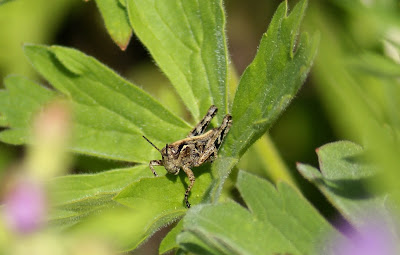
Last weekend, my family went rock-climbing in the Wyoming Range. Even though Jim and I were much better at it 25 years/pounds ago, it was a blast. Cass will head off to college next month, so these are the good times. I’m not looking forward to the empty-nest thing at all, and am considering that I might need one of the items from this list: a pair of baby yaks; a Haflinger horse; a Harley Davidson trike; or a snow kite – something to fill what will be a huge chasm in our daily lives at the ranch. Feel free to provide your view, or weigh in on the list.
Anyway, the wildflowers were in full bloom all over the mountains. We climbed some limestone cliffs above a snowfield and there were flowers blooming out of cracks in the rock wall. Here are a few photos from the outing. Please understand that I seem to have a short attention span when it comes to wildflower photography, so if I see a bug on a flower, it’s the bug that gets my attention. The first flower is a columbine; the second is a wild flax; the bee is on some unidentified purple pretty thing; the fourth is my short-attention span thing; I have no idea what species are in the last two photos. Anyone want to help me out?





11 comments:
What the heck is a snow kite? I'm guessing it's not a little-known arctic raptor (Ictina sp.??) that sometimes makes its way south when the lemmings crash?
:-)
Mr. Birds-on-the-brain:
Who the heck ever heard of that bird? It's not in my bird books, and I can't even score with a Google search. I doubt that I am responsible enough to have a hawk or falcon, so no, not that kind of snow kite.
My kind of snow kiting is the kind you where strap on a huge kite to propel yourself on skis. You can ski uphill, off jumps, cross-country, as long as you have wind. It just seems like it would be a good midlife crisis sport for a Wyoming redneck chick (since I already shoot for fun).
Wild guesses: Could the last one be a catchfly or another relative in the "pink" family? It looks a bit like our local species, royal catchfly (Silene regia), but I don't think it's actually that species.
For the one before it, possibly Indian paintbrush (Castilleja coccinea) or a close relative, just starting to bloom?
I'm guessing the last one is a Scarlet Gilia (Gilia aggregata), from the Phlox family. It's also called Skyrocket, Foxfire and Polecat Plant, according to my guide. Says odor from the crushed leaves smell, well, skunk-like. I also suspect the one before is a budding Indian paintbrush, but I'll have to look it up.
Anne in VA
I now think the next to last is actually a Splitleaf Painted Cup (Castilleja rhexifolia), same family as the paintbrush (Figwort), and all casually called the Wyoming Paintbrush, the state flower. Apparently it has a "semi-"parasitic relationship with sagebrush, which could inspire a short story in itself.
And for my final entry ( I love wildflowers!) I think the purple flower with the bee is a Silky Phacelia (Phacelia sericea), Waterleaf family, also called Purple Fringe, and Scorpionweed. The stamens were a clue. Shameless.
My guide, written by John and Frank Craighead (the very), says that this plant reaches its peak of bloom about the same time "young golden eaglets make their first flight from the nest and trumpter swan cygnets are about half grown." Elk, deer and goats love it. Grizzlies maybe.
Excellent work, flora detectives! Anne, thanks for your dedication on this. I'm pretty familiar with the wildflowers on our sheep range (because I have a friend who is a botanist and convince him to take me for walks), but am a failure when it comes to wildflowers in our local mountains. I guess I'd better find a good field guide - I'll check out the Craighead volume.
The field guide to Rocky Mountain Wildflowers is part of the Peterson series. I was more than a bit embarrassed to see that the Craigheads had written it, something I had not noticed before. I'm sure there are more thorough and recent guides, but this one fits my casual curiosity nicely.
Wildflower guides, even the best, are hit-or-miss, I've found, once you venture beyond the usual suspects. No single book ever seems adequate, but how many can you carry in the field?
Another biologically literate river guide and I recently hiked eight miles through the Selway-Bitterroot Wilderness, each with a good flower book in hand, looking up virtually everything we didn't already know. Nonetheless, our rate of solid IDs was under 10%; how we were thrilled finally to nail one (pipsissewa)! But we mostly missed, even on some very distinctive looking stuff, including some really excellent saprophytes. Either the Selway-Bitterroot contains a lot of really odd stuff (not out of the question) or manageably-sized books just can't provide enough coverage for botanically diverse areas.
Scarlet gilia was my first guess for the last one too. Anybody know one that looks a lot like scarlet gilia, but with peach-colored flowers?
Jackson,
According to my guide, the scarlet gilia have great color variations, from the typical bright scarlet to pale pink, or yellowish speckled with red. My best field guide for this area is "Sagebrush Country, A Wildflower Sanctuary" by Ronald J. Taylor, published by Mountain Press Publishing in Missoula. We were given our copy as a gift about a decade ago, and it's bursting at the seams with our prints, and held together with a huge binder clip.
I hope you get those yaks, and please post lots of photos of them when you do!....L.B.
Post a Comment